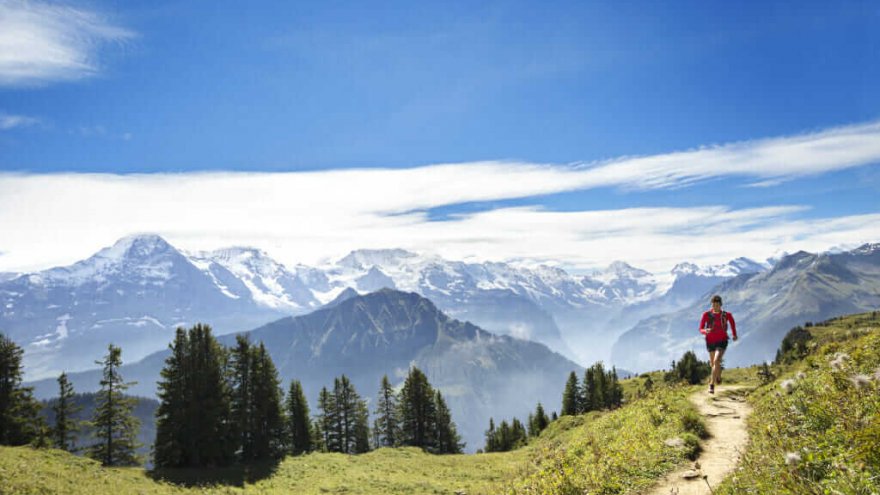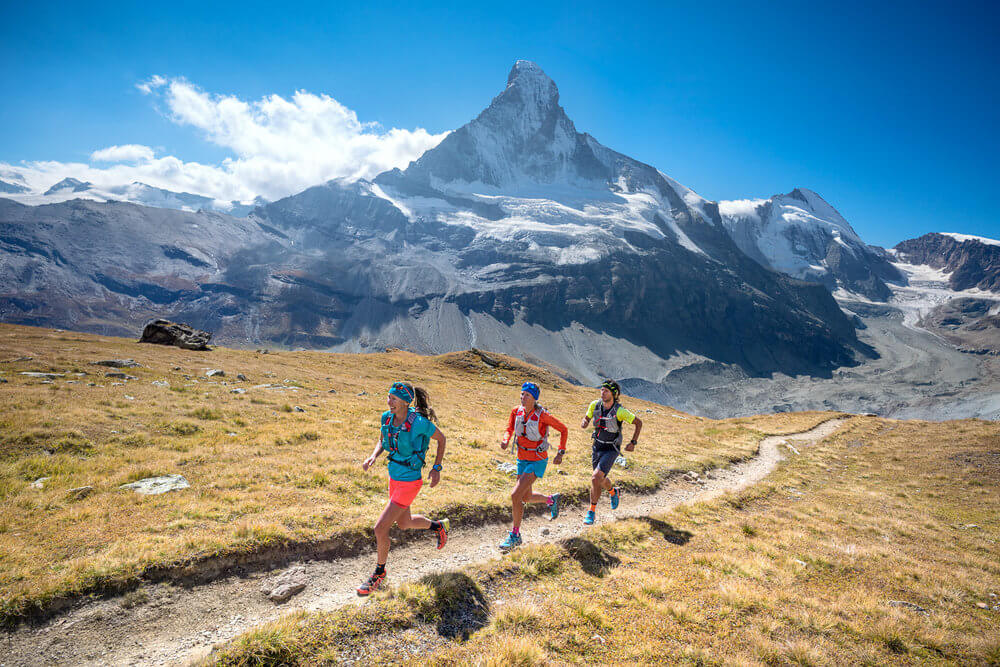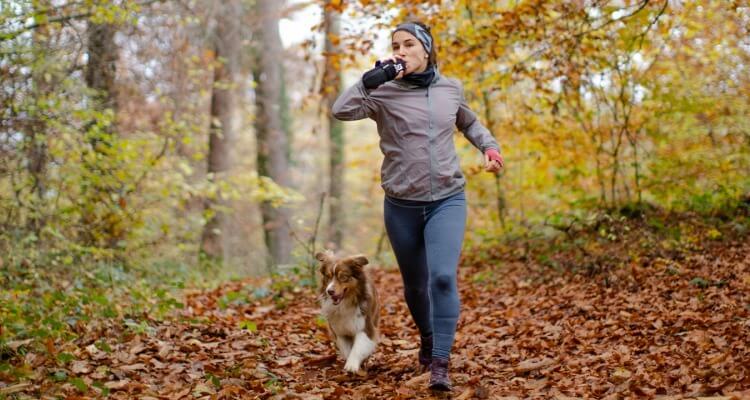Trail Running For Beginners: Simple Guidance For New Trail Runners

Just think about how peaceful it will be: enjoying the quiet of the woods as you head down a quiet trail. If you are interested in trail running for beginners, there are some simple tips to help you find success!
Is Trail Running Harder Than Road Running?
Trail running can feel harder than road running, depending on the terrain. If you are going up and down hills, jumping over fallen trees and splashing through puddles, you will find it more challenging than running on the road.
Another thing that makes trail running challenging is that you have to watch each and every footfall. One of my favorite things about trail running is that you are so busy concentrating on your footing that you don’t even think about the miles as they pass by. Working your way up and down hills as the trees canopy above you… well, there is nothing quite like it.
If you are new to trail running, one thing to realize is that you will likely run slower than you would in a road race. Due to the challenging terrain, many people average a full minute or two slower than they would on the road. Of course, it does depend on the surface.
Some races happen on very well-groomed paths in parks and if it is relatively flat, you may not notice much difference at all. However, if you are traveling through technical trails, you will for sure notice a difference!
Does Trail Running Burn More Calories?
Running experts maintain that trail running burns roughly 10% more calories than road running. This means that if you are roughing it over challenging terrain, you will reap many benefits.

First, you are going to experience more burn for your workout! Second, your brain will be engaged through your entire workout. This means that you will find the time just flies by! Third, you will experience the beauty of nature. Lastly, trails are challenging and an excellent way to push your own personal limits.
Is Trail Running Dangerous?
Honestly, that depends on where and how you are running. Sure, if you are running trails in certain areas, it can be very dangerous. What are those dangers:
- Tripping or Falling – You are always in danger of tripping, falling or twisting an ankle. When you are on a trail, however, the danger of such a thing is compounded. First, because there are so many things you can fall on. Also, because you may not be found if you do injure yourself.
- Getting Lost – Unless you are in an area that you know well, there is the danger of getting lost. In some areas, you could be in danger of exposure to the elements if you get lost. Areas of the mountains, for example, can go from a warm temp to dangerously cold temps in just a short span of time.
- Running Out of Fuel or Water – If you are on a new trail you should always carry food and water. If you get lost or turned around, running out of food or getting dehydrated can be life-threatening.
- Wild Animals – Especially in certain areas, wild animals are a big hazard. You need to educate yourself on the types of animals you might encounter in any area you visit.
- Stings and Insect Bites – Although most of us don’t fear a few bugs, insect stings or bites can really take a turn quickly. This is especially true for people with allergies or sensitivities to insect bites.
- Strangers – While many people enjoy meeting new people, encountering a stranger on a trail may not be the place to do it. Although most people who frequent trails are exercising enthusiasts just like you, you just never know.
How Do I Start Trail Running?
If you are ready to start trail running, the first thing to do is invest in a pair of trail-specific shoes. Trail shoes tend to have better traction to help you stay upright on difficult terrain. With an added rock plate, trail shoes give you an added layer of protection. In addition, trail shoes are stiffer with a more durable exterior.
You should also wear higher socks when running on trails. This is important to protect your ankles and shins from debris such as weeds, grass and other items that you might encounter. Also, high socks give you another layer to keep bugs from your skin. Your socks should be comfortable, cushioned and made of a synthetic material that will easily dry and not cause blisters if you happen to land in a stream or large puddle.

You may also wish to wear long sleeves, or at least wrap a long sleeve shirt for running around your waist, for a couple of reasons. First, a thin, long sleeve shirt helps offer protection from the sun. If you find yourself deep in the woods and the bugs get bad, you will be glad you have something to cover yourself up.
This brings us to another thing. You will probably want bug and mosquito spray if you plan to go deep into wooded or primitive trails. The insects can get pretty feisty out there! While you’re at it, pack more than you think you will need of everything. Food, water, extra gear: if you’re heading out for a longer run, pack double what you anticipate needing.
It is important to remember that when just starting, be kind to yourself.
Adjusting Your Expectations
As stated before, start slow. Literally, just slow down and take it all in. If you normally run 8-minute miles, think about slowing yourself down to 9:30 or 10:00 minute miles. Enjoy the moment. Take in every footfall. Challenge yourself with some crazy hills. Be in the moment.
Keep your eye on the trail at all times. Unlike road running, when on the trail you are looking down all the time. This is necessary to ensure you don’t fall or step on something you should not step on.
Running with a buddy and/or running with a dog is a good idea, especially on a trail. Company is never a bad idea in a quiet, secluded area.
If you have been contemplating taking your workout regiment off-road, you really should branch out and explore these areas. You won’t regret it.
Latest Articles
 Is Running on a Treadmill Easier Than Running Outside?Runners have their own preferences, whether it is treadmill running, running outside on the road, or exploring trails. So...
Is Running on a Treadmill Easier Than Running Outside?Runners have their own preferences, whether it is treadmill running, running outside on the road, or exploring trails. So... Is It OK to Use Trail Running Shoes on the Road?While trail running shoes can be used on roads, especially in situations where a runner encounters mixed terrains or pref...
Is It OK to Use Trail Running Shoes on the Road?While trail running shoes can be used on roads, especially in situations where a runner encounters mixed terrains or pref... How to Fix Sore Quads After Running?Rest, ice, gentle stretching, and over-the-counter pain relievers can help soothe sore quads after running. Also, ensure ...
How to Fix Sore Quads After Running?Rest, ice, gentle stretching, and over-the-counter pain relievers can help soothe sore quads after running. Also, ensure ... 10 Fruits With The Most Electrolytes to Replace Sports DrinksThese fruits are high in electrolytes such as potassium, magnesium, and calcium, essential for hydration, muscle function...
10 Fruits With The Most Electrolytes to Replace Sports DrinksThese fruits are high in electrolytes such as potassium, magnesium, and calcium, essential for hydration, muscle function...

